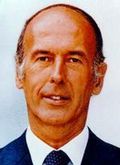 |
Valéry-Marie-René-Georges Giscard d'Estaing
b. 2 Feb 1926, Koblenz (now in Rhineland-Palatinate), Germany
d. 2 Dec 2020, Authon, Loir-et-Cher, France
|
| Title: |
Président de la République (President of the Republic) |
| Term: |
27 May 1974 - 21 May 1981 |
| Chronology: |
24 May 1974,
election to the office of Président de la République is declared upon counting popular votes (cast 19 May 1974),
decision of the Constitutional Council (Conseil constitutionnel) of 24 May 1974 [1] |
|
27 May 1974,
assumed the functions of office, public ceremony, salle des Fêtes, Palais de l'Elysée, Paris [2] |
|
21 May 1981,
ceased to exercise the functions of office upon the installation of a successor [3][4] |
| Biography: |
| When President Georges Pompidou unexpectedly died in 1974, François Mitterrand declared his candidacy as representative of the united left, while the conservatives failed to agree on a candidate. The Gaullists nominated Prime Minister Jacques Chaban-Delmas, but a sizable minority of the UDR declared support for a non-Gaullist, Valéry Giscard d'Estaing, who was the leader of the Independent Republicans. Giscard won over Chaban-Delmas in the first round and narrowly defeated Mitterrand in the runoff. The new president declared his goal to be the transformation of France into "an advanced liberal society." As prime minister he chose the young and forceful Jacques Chirac, leader of the Gaullist minority. The new leadership reduced the voting age to 18, legalized abortion within certain limits, and instituted measures to protect the environment. But the course of reform was stalled by the oil crisis of 1973. Industrial production slowed, unemployment rose, and inflation threatened. As discontent grew, Giscard's leadership was challenged by his ambitious prime minister, Chirac. Open rivalry between the two men led Giscard to dismiss Chirac in favor of Raymond Barre, a professional economist. These factional conflicts on the right opened new prospects for the coalition of the left, but the Socialist-Communist alliance fell apart and enabled the conservatives to retain control of the National Assembly in the 1978 elections. When Giscard's presidential term ended in May 1981, opinion polls seemed to indicate that he would be elected to a second term. He overcame a vigorous challenge by Chirac in the first round of voting and seemed well placed to defeat the Socialist Mitterrand in the runoff. But Mitterrand surprised the pollsters by scoring a slim victory - the first major victory for the left in three decades. |
| Biographical sources: "Valéry Giscard d'Estaing", by Frédéric Abadie and Jean-Pierre Corcelette (Nouveau Monde, 2009) |
| Elections: |
| Candidate |
Popular vote (5 May 1974) |
Popular vote (19 May 1974) |
| registered voters |
30,602,953 |
30,600,775 |
| votes cast |
25,775,743 |
26,724,595 |
| valid votes |
25,538,636 |
26,367,807 |
| absolute majority |
12,769,319 |
13,183,904 |
| Jacques-Pierre-Michel Chaban-Delmas |
3,857,728 |
- |
| René-Fernand Dumont |
337,800 |
- |
| Valéry-René-Marie-Georges Giscard d'Estaing |
8,326,774 |
13,396,203 |
| Guy-Maurice-Émile Héraud |
19,255 |
- |
| Alain Krivine |
93,990 |
- |
| Arlette-Yvonne Laguiller |
595,247 |
- |
| Jean-Marie Le Pen |
190,921 |
- |
| François-Maurice-Adrien-Marie Mitterrand |
11,044,373 |
12,971,604 |
| Émile Muller |
176,279 |
- |
| Bertrand Renouvin |
43,722 |
- |
| Jean-Auguste-Marie-François Royer |
810,540 |
- |
| Jean-Claude Sebag |
42,007 |
- |
|
| Source of electoral results: JORF - Lois et décrets, No. 109, 8 Mai 1974, p. 4899; JORF - Lois et décrets, No. 123, 24-25 May 1974, p. 5669. |
| |
| [1] |
JORF - Lois et décrets, No. 123, 24-25 May 1974, p. 5669. |
| [2] |
Le Monde, No. 9133, 28 May 1974, pp. 1, 13. |
| [3] |
Le Monde, num. 11292, 21 Mai 1981. |
| [4] |
The Decision of the Constitutional Council of 15 May 1981 authorised the outgoing President of the Republic to choose any time for the transfer of office, but not later than at 00:00 24 May 1981 (Journal officiel de la République française. Lois et Décrets. N° 115. Samedi 16 Mai 1981. P. 1467); ceremony of investitute took place 21 May 1981. |
|
Image: photograph by François Pages. |